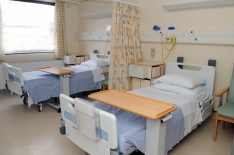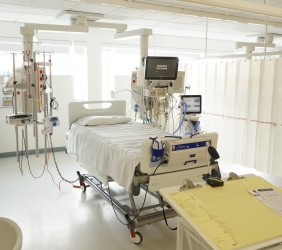Perioperative Care
Preoperative stratification
The purpose of perioperative risk stratification is to allow:
- Proper informed consent to undergo the procedure with full knowledge of the risk of morbidity and mortality.
- Effective resource allocation in terms of critical care usage – essentially putting the right person in the right place.
- Identifying individuals who may benefit from further preoperative investigations and treatment such as cardiology referrals or for example beta blockade.
- Potentially altering or deferring the procedure if the clinician and/or patient think the risk too great.
In York we currently stratify an individual’s risk from surgery as normal, intermediate or high based on cardiopulmonary exercise testing. The risk stratification is based on the variation around the overall cohort mortality for major abdominal surgery (non-vascular) of 1.8% which is lower that the reported national average.
Patients score one point for each of the following variables:
Minute ventilation/carbon dioxide production (VE/VCO2)>34
Anaerobic threshold < 11 ml/kg/min
Cardiac abnormality on exercise testing
York
CPET score
≤1
Normal risk: Standard care on the ward
 The predicted mortality for this group is less than 1% and this represents some two thirds of our patient cohort. Subjects in this group will be managed on the standard pathway pathway.pdf. On the standard pathway the only mandated care is optimal fluid management and appropriate analgesia, patients undergoing prolonged surgery will receive arterial blood pressure monitoring and fluid optimisation at the discretion of the anaesthetist.
The predicted mortality for this group is less than 1% and this represents some two thirds of our patient cohort. Subjects in this group will be managed on the standard pathway pathway.pdf. On the standard pathway the only mandated care is optimal fluid management and appropriate analgesia, patients undergoing prolonged surgery will receive arterial blood pressure monitoring and fluid optimisation at the discretion of the anaesthetist.
If arterial access is present patients will have a blood lactate measured at 2 hours post operatively and if normal will return to the ward environment for post-operative care. If lactate measurements show an abnormality patients will be upgrade to the enhanced pathway enhanced pathway for aneasthatists
York
CPET score
2
Intermediate risk: Enhanced care on level 1 unit within surgical ward
For major elective colorectal surgery, the predicted mortality for this group is 3.1% and this represents approximately 25% of our patient cohort. Subjects in this group will be manage on the enhanced pathway pathway.pdf. All patients will receive an arterial line and intra-operative fluid optimisation based on pulse contour analysis cardiac output monitoring, and adequate blood pressure control (MAP>65mmHg) with peripheral vasopressors as required.
Historically this patient cohort has been managed in critical care in the post-operative period. With our enhanced nurse led haemodynamic protocols this cohort now returns to a level 1 unit based in a ward environment. Patients return to this unit with arterial lines in situ, and remain on an advanced cardiac output monitor for the nursing staff to adequately manage the need for fluid and vasopressors with a protocolised pathway.
York
CPET score
3
High Risk: Enhanced care on critical care
 The predicted mortality for this group is 9.1% and this represents approximately 10% of our patient cohort. Subjects in this group will be managed on the enhanced pathway as per the intermediate group in addition they also receive central venous access for noradrenaline infusions to maintain an adequate MAP.
The predicted mortality for this group is 9.1% and this represents approximately 10% of our patient cohort. Subjects in this group will be managed on the enhanced pathway as per the intermediate group in addition they also receive central venous access for noradrenaline infusions to maintain an adequate MAP.
Subjects in this group are managed in critical care post-operatively; however with the success of the nurse led protocols we envisage we will be able to manage this group successfully on our level 1 unit.
The above represents the basis of how patients are risk stratified in York, this does not replace clinical judgement and the treating clinician may choose to upgrade a patient to the Enhanced Pathway., for example if a patient had significant frailty, poor nutrition or other markers of risk.
In addition, at the end of surgery we perform the Surgical Apgar Score (SAS) to account for intra-operative factors such as blood loss which may also lead to a patient being ‘upgraded’ to the enhanced pathway and either going to the level 1 unit or HDU depending on the patient’s condition.

